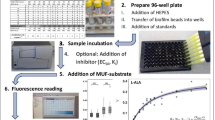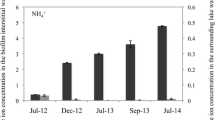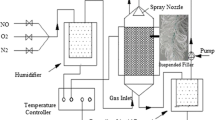Abstract
Extracellular polymeric substances (EPS) contribute to biofilm stability and adhesion properties. The EPS matrix might also be a site for free extracellular enzyme activity; however, little is known about participation of enzyme activity in EPS during biofilm formation. In this study, we analyzed the activities of β-glucosidase, leu-aminopeptidase, and β-glucosaminidase during the colonization of artificial substrata (glass tiles) in a stream distinguishing enzyme activity in EPS matrix (matrix-enzymes) and total biofilm extracellular enzyme activity. The 1-h incubation of a biofilm suspension and cation-exchange resin followed by centrifugation seems appropriate to extract the matrix fraction (supernatant) and measure matrix enzymes (including free and linked to EPS) in freshwater biofilms, although there is a methodological limitation for using a biofilm suspension instead of an undisrupted biofilm. Total biofilm activities and matrix-enzyme activities showed similar capabilities to decompose organic matter compounds, with a greater capacity for peptide decomposition (leu-aminopeptidase) than for polysaccharides (β-glucosidase), and a low decomposition of chitin and peptidoglycan (β-glucosaminidase). Matrix-enzyme activity increased with colonization time, but more slowly than that of total enzyme activity. At the beginning of the colonization experiment (days 1–4) matrix enzymes accounted for 65–81% of total biofilm enzyme activity. Higher proportion of polysaccharides in EPS versus total biofilm, and higher matrix-enzyme activities per microgram of polysaccharides in the EPS were measured during the first 1–3 days of biofilm formation, indicating a high rate of enzyme release into the matrix during this period. Relative contribution of matrix-enzyme activities decreased as biofilm matures, but was maintained at 13–37% of total enzyme activity at the 42- to 49-day-old biofilm. These enzymes, retained and conserved in the EPS, may contribute to community metabolism. When analyzing extracellular enzymes in biofilms, the contribution of matrix enzymes must be considered, especially for young biofilms.




Similar content being viewed by others
References
Ács E, Kiss KT (1993) Colonization processes of diatoms on artificial substrates in the River Danube near Budapest (Hungary). Hydrobiologia 269/270:307–315
Barranguet C, VanBeusekom SAM, Veuger B, Neu TR, Manders EMM, Sinke JJ, Admiraal W (2004) Studying undisturbed autotrophic biofilms: still a technical challenge. Aquat Microb Ecol 34:1–9
Battin TJ, Kaplan LA, Newbold JD, Hansen CME (2003) Contributions of microbial biofilms to ecosystem processes in stream mesocosms. Nature 426:439–442
Bayles KW (2007) The biological role of death and lysis in biofilm development. Nature Rev Microbiol 5:721–726
Bhaskar PV, Bhosle NB (2005) Microbial extracellular polymeric substances in marine biogeochemical processes. Curr Sci 88:45–53
Blenkinsopp SA, Lock MA (1992) Impact of storm-flow on electron transport system activity in river biofilms. Freshw Biol 27:397–404
Chamier AC (1985) Cell-wall-degrading enzymes of aquatic hyphomycetes: a review. Bot J Linn Soc 91:67–81
Chróst RJ (1991) Microbial enzymes in aquatic environments. Springer, New York, 310 pp
Comte S, Guibaud G, Baudu M (2006) Relations between extraction protocols for activated sludge extracellular polymeric substances (EPS) and EPS complexation properties Part I. Comparison of the efficiency of eight EPS extraction methods. Enzyme Microb Technol 38:237–245
Cooksey KE, Wigglesworth-Cooksey B (1995) Adhesion of bacteria and diatoms to surfaces in the sea: a review. Aquat Microb Ecol 9:87–96
Costerton WJ, DeBeer D, Lewandowski Z (1994) Biofilms, the customized niche. J Bacteriol 176:2137–2142
Costerton JW, Lewandowski Z, Caldwell DE, Korber DR, Lappin-Scott HM (1995) Microbial biofilms. Annu Rev Microbiol 49:711–745
Dubois M, Gilles KA, Hamilton JK, Rebers PA, Smith F (1956) Colorimetric method for determination of sugars and related substances. Anal Chem 28:350–356
Francoeur SN, Wetzel RG, Neely RK (2001) New spatially explicit method for detecting extracellular protease activity in biofilms. Appl Environ Microbiol 67:4329–4334
Francoeur SN, Wetzel RG (2003) Regulation of periphytic leucine-aminopeptidase activity. Aquat Microb Ecol 31:249–258
Freeman C, Lock MA (1992) Recalcitrant high-molecular-weight material, an inhibitor of microbial metabolism in river biofilms. Appl Environ Microbiol 58:2030–2033
Freeman C, Lock MA (1995) The biofilm polysaccharide matrix: a buffer against changing organic substrate supply. Limnol Oceanogr 40:273–278
Frølund B, Griebe T, Nielsen PH (1995) Enzymatic activity in the activated sludge floc matrix. Appl Microbiol Biotechnol 43:755–761
Frølund B, Palmgren R, Keiding K, Nielsen PH (1996) Extraction of extracellular polymers from activated sludge using a cation exchange resin. Water Res 30:1749–1758
Hamilton WA (1987) Biofilms: microbial interactions and metabolic activities. In: Fletcher M, Gray TRG, Jones JG (eds) Ecology of microbial communities. Symposium 41. The Society for General Microbiology, Cambridge University Press, Cambridge, MA, pp 361–385
Hoppe HG (1983) Significance of exoenzymatic activities in the ecology of brackish water: measurement by means of methylumbelliferyl-substrates. Mar Ecol Prog Ser 11:299–308
Kreft JU (2004) Biofilms promote altruism. Microbiology 150:2751–2760
Lock MA (1993) Attached microbial communities in rivers. In: Ford TE (ed) Aquatic microbiology: an ecological approach. Blackwell, Oxford, pp 113–138
Lock MA, Wallace RR, Costerton JW, Ventullo RM, Charlton SE (1984) River epilithon: toward a structural-functional model. Oikos 42:10–22
Low CSF, White DC (1989) Regulation of external polymer production in benthic microbial communities. In: Cohen Y, Rosenberg E. (eds) Microbial Mats: physiological ecology of benthic microbial communities. American Society for Microbiologypp 228–238
Marshall KC (1971) Mechanism of the initial events in the sorption of marine bacteria to surfaces. J Gen Microbiol 68:337–348
Marshall KC (1992) Biofilms: an overview of bacterial adhesion, activity, and control at surfaces. ASM News 58:202–207
Neu TR, Lawrence JR (1997) Development and structure of microbial biofilms in river water studied by confocal laser scanning microscopy. FEMS Microbiol Ecol 24:11–25
Neu TR, Swerhone GDW, Bockelmann U, Lawrence JR (2005) Effect of CNP on composition and structure of lotic biofilms as detected with lectin-specific glycoconjugates. Aquat Microb Ecol 38:283–294
Ramasamy P, Zhang X (2005) Effects of shear stress on the secretion of extracellular polymeric substances in biofilms. Water Sci Technol 52:217–223
Romaní AM, Sabater S (1999) Effect of primary producers on the heterotrophic metabolism of a stream biofilm. Freshw Biol 41:729–736
Romaní AM, Guasch H, Muñoz I, Ruana J, Vilalta E, Schwartz T, Emtiazi F, Sabater S (2004) Biofilm structure and function and possible implications for riverine DOC dynamics. Microb Ecol 47:316–328
Romaní AM, Giorgi A, Acuña V, Sabater S (2004) The influence of substratum type and nutrient supply on biofilm organic matter utilization in streams. Limnol Oceanogr 49:1713–1721
Sabater S, Romaní AM (1996) Metabolic changes associated with biofilm formation in an undisturbed Mediterranean stream. Hydrobiology 335:107–113
Stoodley P, Wilson S, Hall-Stoodley L, Boyle JD, Lappin-Scott HM, Costerton JW (2001) Growth and detachment of cell clusters from mature mixed-species biofilms. Appl Environ Microbiol 67:5608–5613
Thompson AJ, Sinsabaugh RL (2000) Matric and particulate phosphatase and aminopeptidase activity in limnetic biofilms. Aquat Microb Ecol 21:151–159
Vrba J, Simek K, Nedoma J, Hartman P (1993) 4-Methylumbelliferyl-β-N-Acetylglucosaminide hydrolysis by a high-affinity enzyme, a putative marker of protozoan bacterivory. Appl Environ Microbiol 59:3091–3101
Yallop ML, Paterson DM, Wellsbury P (2000) Interrelationships between rates of microbial production, exopolymer production, microbial biomass, and sediment stability in biofilms of intertidal sediments. Microb Ecol 39:116–127
Zhang X, Bishop PL (2003) Biodegradability of biofilm extracellular polymeric substances. Chemosphere 50:63–69
Zippel B, Neu TR (2005) Growth and structure off phototrophic biofilms under controlled light conditions. Water Sci Technol 52:203–209
Acknowledgments
This study was supported by an Integrated Action Germany–Spain (project HA2004-0020) and the project CGL2005-06739-C02-02 from the Spanish Ministry of Science and Education. Thanks to L. Proia for helping in the live/dead bacterial counting. We also thank the comments and suggestions from four anonymous reviewers on the first version of the manuscript.
Author information
Authors and Affiliations
Corresponding author
Rights and permissions
About this article
Cite this article
Romaní, A.M., Fund, K., Artigas, J. et al. Relevance of Polymeric Matrix Enzymes During Biofilm Formation. Microb Ecol 56, 427–436 (2008). https://doi.org/10.1007/s00248-007-9361-8
Received:
Revised:
Accepted:
Published:
Issue Date:
DOI: https://doi.org/10.1007/s00248-007-9361-8




